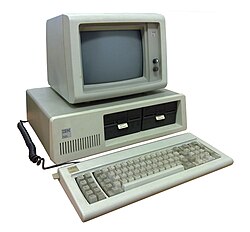IBM-PC

|
|
| Type | Personal computer |
|---|---|
| Release date | August 12, 1981 |
| Discontinued | April 2, 1987 |
| Operating system | IBM BASIC / PC DOS 1.0 CP/M-86 UCSD p-System |
| CPU | Intel 8088 @ 4.77 MHz |
| Memory | 16 kB ~ 256 kB |
| Sound | 1-channel PWM |
| Predecessor | IBM Datamaster |
| Successor |
IBM Personal Computer XT IBM PCjr IBM Portable Personal Computer IBM Personal Computer/AT IBM PC Convertible |

IBM 5150 PC with IBM 5151 monitor
|
The IBM Personal Computer, commonly known as the IBM PC, is the original version and progenitor of the IBM PC compatible hardware platform. It is IBM model number 5150, and was introduced on August 12, 1981. It was created by a team of engineers and designers under the direction of Don Estridge of the IBM Entry Systems Division in Boca Raton, Florida. In 1983, with sales overtaking the Apple II, it became the best-selling desktop computer.
The generic term "personal computer" was in use before 1981, applied as early as 1972 to the Xerox PARC's Alto, but because of the success of the IBM Personal Computer, the term "PC" came to mean more specifically a desktop microcomputer compatible with IBM's PC products. Within a short time of the introduction, third-party suppliers of peripheral devices, expansion cards, and software proliferated; the influence of the IBM PC on the personal computer market was substantial in standardizing a platform for personal computers. "IBM compatible" became an important criterion for sales growth; only the Apple Macintosh family kept significant market share without compatibility with the IBM personal computer. IBM, which had been solidly established in the market of mainframe computers, had rushed to catch up to Apple in this new market, and in the process had taken engineering shortcuts that relied on outsourced hardware and software, a break from the norm in the company's development of their computers. With the reverse engineering of the BIOS in 1984, this enabled the entire IBM PC platform to be copied, opening the market to a flood of "IBM PC clones". The combined success of IBM original and compatible knock-offs led to the dominance of what became known as "Wintel", the CPU/OS hardware/software pairing of Intel and Microsoft, which catapulted both of these companies into respective positions of dominance. The IBM clones sold so successfully that IBM eventually lost control of this market, and by the summer of 2004, 20 years after the introduction of the IBM PC, the company had decided to exit the PC market entirely. The IBM PC had been discontinued after the first quarter of 1987.
...
Wikipedia
